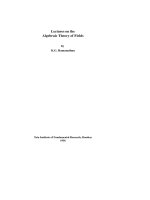- Trang chủ >>
- Sư phạm >>
- Sư phạm toán
ANVANDED ABSTRACT ALGEBRA
Bạn đang xem bản rút gọn của tài liệu. Xem và tải ngay bản đầy đủ của tài liệu tại đây (96.89 KB, 8 trang )
ANVANDED ABSTRACT ALGEBRA
ACTIONS OF GROUP ON A SET
Let G be a group
Z(G) = { z G | zx=xz x G}
EX1, Check that Z(G) is a subgroup of G
i)
x G, one has :
1Gx=x1G ( 1G G)
ii)
1G Z(G)
Z(G)
z1,z2 Z(G)
z1x=xz1; z2x=xz2
(*)
x G)
x G, z1,z2 Z(G), one has:
(z1z2)x = z1( z2x) = z1(xz2) = (z1x)z2 = (xz1)z2 = x(z1z2)
iii)
z1z2 Z(G) (**)
x G => x-1 G ( since G be a group)
z Z(G), x G, one has:
zx-1 = x-1z
(zx-1)-1 = (x-1z)-1
xz-1 = z-1x
z-1 Z(G) (***)
From (*) and (**) and (***) , this implies Z(G) is subgroup of G
EX2,Let G ba a group such that G/Z(G) is cyclic. Prove that G = Z(G) if G is
abelian
•
•
G/Z(G) is cyclic group
g G such that G/Z(G) =
g1,g2 G
g1Z(G), g2Z(G)
m,n N such that g1Z(G) = gmZ(G), g2Z(G) = gnZ(G)
g1 = gmk, g2 = gnk’ ( k, k’ Z(G))
g1,g2 G,one has:
g1 g2 = (gmk)(gnk’) = gm (kgn )k’ = gm (gnk )k’= gm+n( k k’)
g2 g1 = (gnk’)(gmk) = gn (k’gm )k = gn (gmk’ )k= gm+n( k’ k)
Since k,k’ Z(G) => kk’ = k’k
So, g1 g2 = g2 g1
•
G is abelian
We see that : Z(G) G
Since G is Abelian so g G
gx = xg x G
g Z(G)
G
Thus G = Z(G) if G is Abelian
EX3, Let p be a prime integer. Prove that any group G with p2 element is
Abelian
G be a finite group with p2 element ( p be a prime number). Then Z(G) has more
than one element so by Lagrange’s theorem |Z(G)| is a divisor of |G| . On the other
hand , p be a prime integer thus Z(G) has oder p2 or p
•
•
If Z(G) has oder p
|G/Z(G)| =
G/Z(G) has order p.
On the other hand, p is prime number thus G/Z(G) is cyclic
By EX2 G is Abelian so G = Z(G) ( contracdiction since |G| )
So this case cannot arise.
If Z(G) has oder p2
We see that Z(G) G
On the other hand | Z(G)| = |G| = p2 < +
Thus Z(G) = G
Since Z(G) is Abelian so G is Abelian
EX4) A group with p2 elements is either cyclic or isomorphic to the
direct product
•
If G has an element a of order p2, then G is cyclic group G =
•
If G has no element of oder p2
Every non-identity elements of G has oder p
Let x be any such element, so that has p elements. Now we choose
any element of G not in .
Since = {1}
It follows that the p2 elements {xixj: 0 are all disctinct and so are
all the elements of G. it may then be checked that the map f : xixj
(xi,xj)
One has f (xixj) =
Is, in fact, an isomorphism between G and direct product of the
groups
We conclude thus section with a generalization of a fact we have
already established
/>heory.pdf
/> /> />amsF09/GExam1Soln.pdf
/>Xác định lớp liên hợp
/>A4 là nhóm của phép thế chẵn
EX5: Let G be the symmetric group S(n) and V be a complex vector
space with basis { }. For G and and of V, define
•
i)
n = 4 and
ii)
n = 4 and
Show that V is a G- set
-
One has
=
=
=)
=
Thus V is a G-set
i)
Since
= S(4)
Orb() =
= }
=
ii)
Since
= { 1, (2 4),(1 3),(1 3)(2 4)}
Orb() =
= }
={
EX6: Let X be a G-set and Show that for any g G, the stabiliser of g; is the
subgroup
The stabiliser of g is the set
{
={
={
={
=
EX7: Determine the list of conjugacy classes in the symmetric group S(4) and
also in the alternating group A(4)
•
Conjugacy classes in S(4) are:
{1}
{ (1 2), (1 3),(1 4),(2 3),(2 4),(3 4)}
{ (1 2 3), (1 3 2), (1 3 4),(1 4 3),(1 2 4),(1 4 2), ( 2 3 4),(2 4 3)}
{( 1 2 3 4),(1 3 2 4),(1 4 3 2),(1 2 4 3),(1 3 4 2)}
{ (1 2)(3 4), (1 3)(2 4), (1 4)(2 3)}
•
Conjugacy classes in A(4)
{1}
{( 1 3 2), (2 3 4),(1 4 3), (1 2 4)}
{(1 2 3), (1 3 4), (1 4 2),( 2 4 3 }
{ (1 2)(3 4), (1 3)(2 4), (1 4)(2 3)}
EX8: Let G be any group and g be an element of G. Prove directly that
is a subgroup of G
•
One has
(*)
•
x1,x2
x1g=gx1; x2g=gx2
x )
xg G, x1,x2 one has:
(x1x2)g = x1( x2g) = x1(gx2) = (x1g)x2 = (gx1)x2 = g(x1x2)
•
x1x2 (**)
g G => g-1 G ( since G be a group)
x , g G, one has:
xg-1 = g-1x
(xg-1)-1 = (g-1x)-1
gx-1 = x-1g
x-1 (***)
From (*) and (**) and (***) , this implies is subgroup of G
EX10 : Let G be the group S(3). Calculate when H is
a) Subgroup {1, (1 2 3), (1 3 2)}
b) Subgroup { 1,(1 2)}
a) One has :
g
1
( 1 2)
(1 3)
(2 3)
(1 2 3)
(1 3 2)
1
1
1
1
1
1
1
(1 2 3)
(1 3 2)
(1 3 2)
(1 3 2)
(1 2 3)
(1 2 3)
(1 3 2)
(1 2 3)
(1 2 3)
(1 2 3)
(1 3 2)
(1 3 2)
We see that
Thus = G
b)
One has
g
1
( 1 2)
(1 3)
(2 3)
(1 2 3)
(1 3 2)
1
1
1
1
1
1
1
(1 2)
(1 2)
(3 2)
(1 3)
(2 3)
(3 1)
= {1, (1 2)} = H
EX9:
Let G
In any group the identity element always forms a conjugacy class on
its own, so if G has precisely two conjugacy classses, all the non-identity
elements lie in one class. Since the number of elements in a conjugacy class
divides n = \G\, we deduce that n — 1 divides n. It then follows that n — 1
divides n — (n — 1) = 1 so that n — 1 = 1 and hence n = 2.









